#geiko shimada
Explore tagged Tumblr posts
Note

Hello there! I ran across this in an antique store recently, and I wonder if you could tell me anything about it? I was very curious, but I can't read the kanji and I'm sure the store had no idea (they'd marked it "geisha wig" which I thought was unlikely.) Thank you!
Sure! It seems you're right; it's VERY likely NOT a geisha wig.
If it's anything like the wig (i.e. katsura) in this link, then it's likely a Taka-Shimada that's ready for use by traditional Japanese brides. This post by MissMyloko explains the subtle differences between an actual Geiko/ Geisha Shimada katsura and the more common bridal Taka-Shimada katsura.
What also makes it obvious that it's not a geisha katsura is the red & white mottoi (i.e. "ribbon") tied behind the maegami (i.e. bangs) as well as the white wire tied & splayed in an open fan shape at the apex of the mage (i.e. topnot). Red & white together are celebratory colors for events like weddings in Japan & most traditional bridal kimono ensembles are mostly white with red accents.
Hope this helps!
32 notes
·
View notes
Text
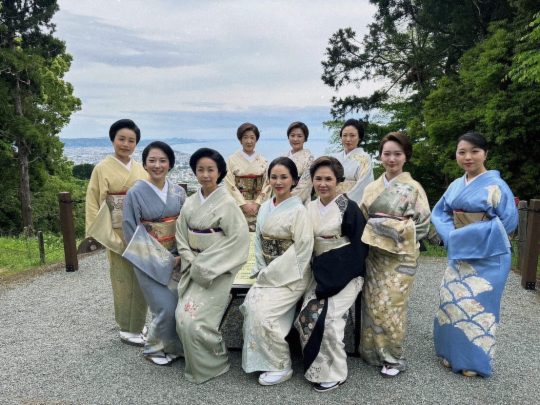
The look of… IX: Hakone-Yumoto Onsen
History Although it‘s likely that Geisha worked in Hakone since the late 19th century, not much can be found about their history. The current Kenban was built in 1950 [1]. In the early/mid 80's (before the bubble economy), 400-450 Geisha lived in Hakone [2]. The Otosan of Ikedaya Okiya reformed the traditional employment system and introduced benefits like pension plans and financial compensations for cancelled jobs [3].
In 2000 latest, the Hakone Yumoto Kenban launched its own website [4], creating a space for Okiya to advertise and look for new members [5]. In 2001, the Okasan of Wakita became the current head of the Geigi Union. In order to ensure the survival of local Hanamachi culture, the Kenban became open to public in 2008, and the Geisha band Basara (婆娑羅) was founded in 2009. [2]
In the late 2010's, around 150 Geisha from age 18 to 80 lived in 32 Okiya. Lack of work during the Corona pandemic reduced their numbers to 109 in 2021. The amount of Geisha working in Hakone has increased meanwhile, with 140 of them active in January 2024, but still hasn‘t reached its pre-pandemic levels. [2]
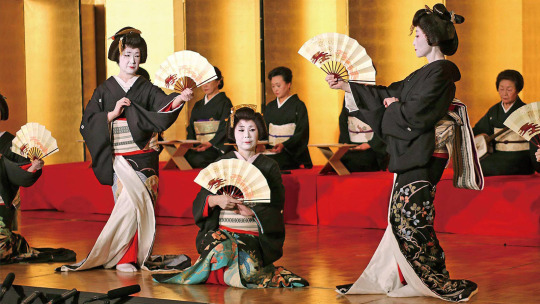
The look of Hakone Maiko
Local term: Kirariko きらり妓
※ Hairstyle: own hair, Shimada mage and Hanaogi mage ※ Kanzashi: Kushi, maezashi, non-seasonal hana kanzashi ※ Make up: western make up or light oshiroi, both lips painted from the start ※ Kimono: Furisode mostly without tucks (rarely with sleeve tucks) ※ Eri: white, white with embroidery (red, red/pink) ※ Obi: Koken musubi ※ Obiage: tied and tucked in, red ※ Obijime: red with simple, rectangular Obidome ※ Footwear: white or black Zori
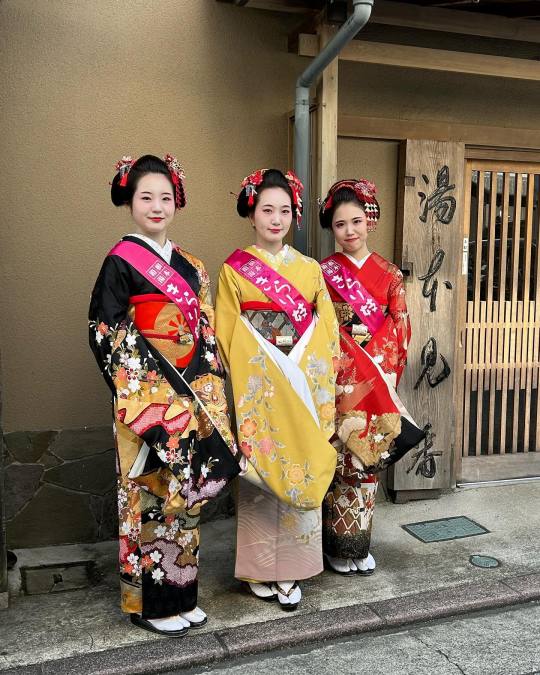
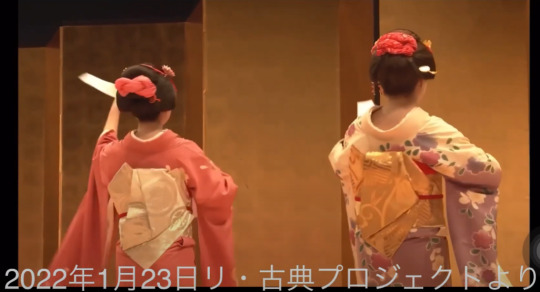
The look of Hakone Geiko
Local term: Geisha
※ Hairstyle: Taka shimada or Tsubushi shimada Katsura ※ Kanzashi: Taka shimada: Kushi, Tama in the back, Kogai in the back, and sometimes in the front too. Tsubushi shimada: Kushi, Tama ※ Make up: Oshiroi ※ Kimono: Mostly Homongi/Tsukesage, sometimes Hikizuri. Kuromontsuki for Tachikata is always a Hikizuri ※ Eri: white, rarely with white or pink embriodery ※ Obi: Yanagi musubi with Kuromontsuki (white/blue Hakata ori), otherwise Otaiko musubi ※ Obiage: always red with Kuromontsuki, otherwise white, pink or light blue. Usually not patterned. ※ Obijime: light-coloured. No Obijime with Yanagi musubi ※ Footwear: Zori, Geta with white or blue Hanao
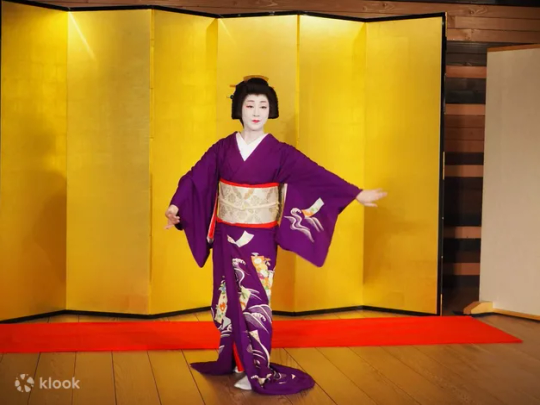
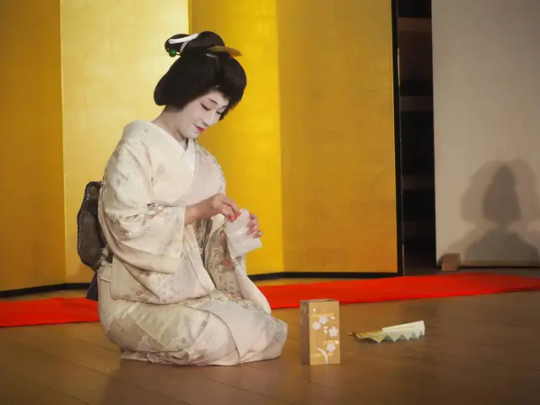
Casual/Jikata style
※ Hairstyle: Yohatsu ※ Kanzashi: usually none, maki (蒔絵) kanzashi at best ※ Make up: western make up ※ Kimono: Kurotomesode, otherwise Homongi ※ Eri: white ※ Obi: Otaiko musubi ※ Obiage: mostly warm pastel colours, but basically anything goes. Not patterned. ※ Obijime: Sometimes with Obidome ※ Footwear: Zôri
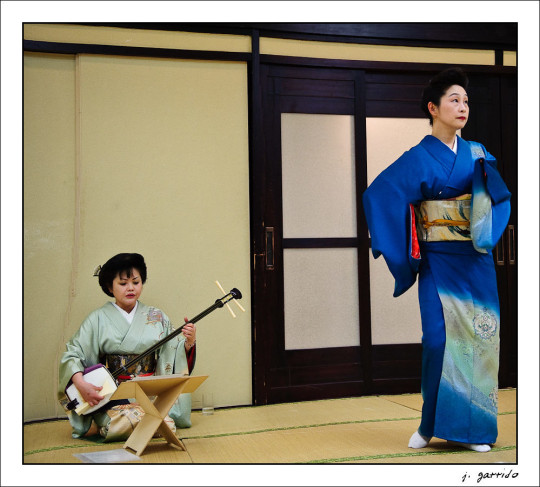
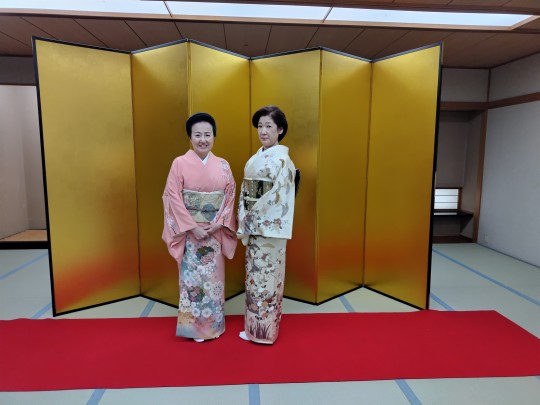
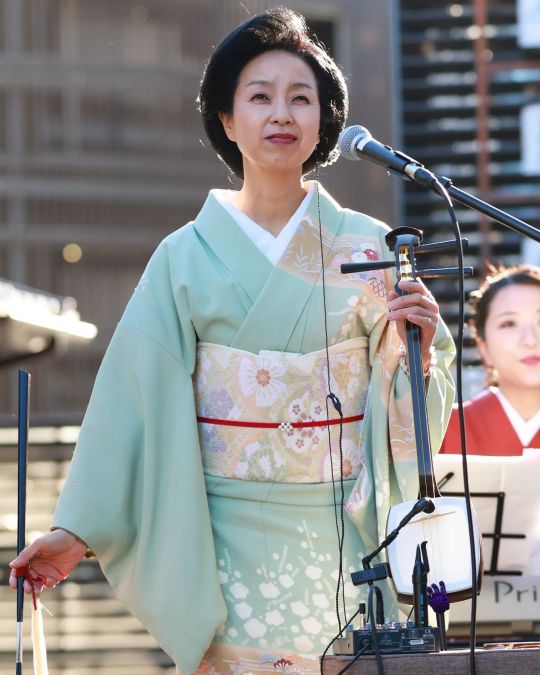
Tachiyaku style
※ Hairstyle: Maeware Katsura ※ Kanzashi: Tama pin in the back ※ Make up: Oshiroi ※ Kimono: Hômongi ※ Eri: white ※ Obi: Koken musubi with mint/light green Kakae Obi (抱え帯) ※ Obiage: red, white, pink or light blue. Obidome not uncommon ※ Obijime: light-coloured
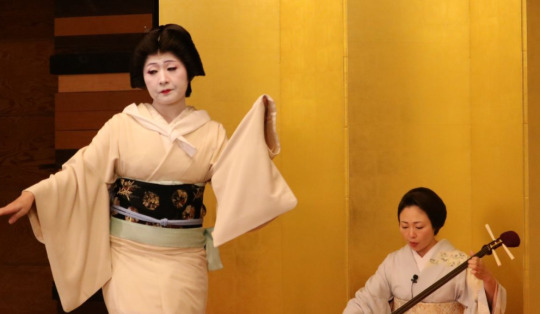
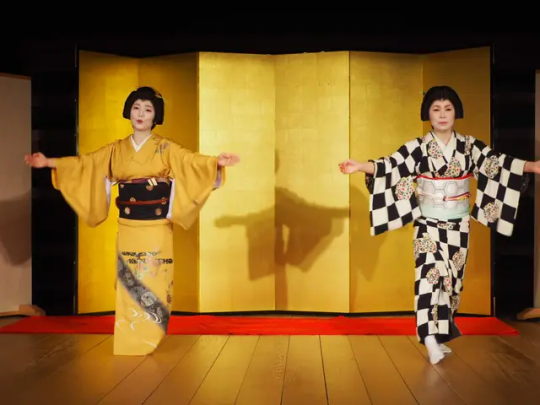
Notes
Arts: The schools taught in Hakone are Nishikawa 西川 (dance), Honjo 本條 (Kouta, Hauta and Min‘yo), Kineya 杵屋 (Nagauta) and Tosha 藤舎 (Hayashi). [6]
Kirariko is a newly coined term in use since 2003 to call junior Geisha in the age group from 18-30. [7] Upon turning 30, Kirariko have to take either a „dancer grade B“ or „dancer grade A“ test. To pass the B test, she has to perform two dances. For the grade A test, she has to perform three female style and three male style dances. [8]
Companions: Okiya recruit and employ companions as well as Geisha. Companions receive a fixed wage, which is usually lower than that of the Geisha, but the customer pays the same price. Companions can be requested to wear either western clothing or Kimono. Western clothing is a business suit provided for free by the Okiya, Kimono can be rented for a set fee by the Okiya as well. [9] Companions receive professional names like Geisha. They don‘t study performing arts and can work part-time. Their job is to serve drinks and food and engage in „pleasant conversation“ with customers at banquets. [10] In my opinion, a good entry-level job in the Karyukai – some companions became Geisha later in their carreer. [11]
Becoming independent: after being Geisha for seven years, you have the opportunity of opening a branch of your debut Okiya. In all cases I know, the new Okiya takes one or two characters from the original Okiya. For example Ikedaya 池田家 → Wakita 和喜田 and Yukieda 雪江田 (田 Kanji is part of the new name). Wakita 和喜田 → Suzuwa すず和 and Yukiwa ゆき和 (和). Kitami 㐂田見 → Kisaya 㐂茶家 (㐂).
Changing Okiya registration: only possible when becoming independent, or when your (biological) mother, sister, or daughter opens a new Okiya.
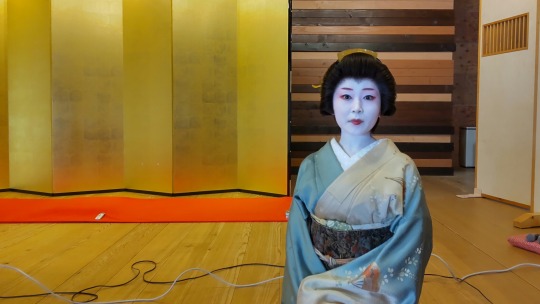
Sources
[1] https://note.com/meetgeisha/n/n1cc907ffd4c9. [2] https://www.tokyo-np.co.jp/article/301712, [3] https://conex-eco.co.jp/hakonesaisai/71824/ [4] https://web.archive.org/web/20000919171055/http://www.geisha.co.jp:80/ [5] https://web.archive.org/web/20001017234326/http://www.geisha.co.jp/okiya-name.htm,[6] https://geisha.co.jp/kenban/, [7] https://web.archive.org/web/20040408030159/http://www11.plala.or.jp/fukunoya/what_is_kirariko.html,[8] https://konohanasakuya.blogspot.com/2012/03/dance-performance.html,[9] https://yukieda.com/kyuujin_answer/, [10] https://yukieda.com/recruit/companion/,[11] https://web.archive.org/web/20080220191156/http://www.00wakita.com/hyousyou.html
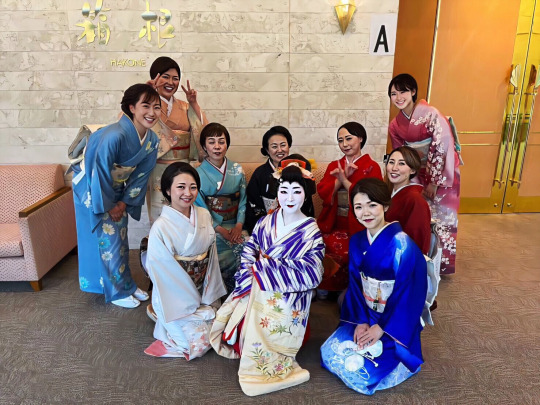
Picture sources: Group picture 2024, Hakone Odori, three Kirariko 2023, Kirariko back view 2023, Geisha dancing, Geisha preparing Tosenkyo set 2019, Sumomo with a dancer 2009, Anzu and Yuho 2023, really nice picture of Yumiko with Kokyu 2022, Chacha dancing 2022, Atsumi and unknown Tachikata 2019, Natsumi 2022, Matsuyoshi new year's picture 2023
31 notes
·
View notes
Note
can you go more in depth on beauty secrets by geishas? i’ve always found them so interesting.
Geisha are very secretive about their inner lives, so it's hard to know for sure things like exactly what they would have done during their skincare routine or what kind of perfume they used, but we do know about their makeup, hair, and clothing. A lot of this information comes from the most successful geiko of Kyoto, Mineko Iwasaki's memoir Geisha, A Life (also known as Geisha of Gion), which was controversial among her peers as she revealed a lot of behind the scenes info on what life as a geisha is like. It's a very interesting read if you're interested in the inner lives of geisha. It can be downloaded on Libgen.
The Geisha Ideal
Mineko Iwasaki described how a geisha is meant to look:
She has the classic looks of a Heian princess, as though she might have stepped out of an eleventh-century scroll painting. Her face is a perfect oval. Her skin is white and flawless, her hair black as a raven’s wing. Her brows are half moons, her mouth a delicate rosebud. Her neck is long and sensuous, her figure gently rounded.
Makeup
Geisha wear highly stylised makeup derived from the kabuki tradition.



Foundation: Bintsuke oil paste is applied to the face, neck, and upper back as a base.
White Makeup: White face powder, made of rice powder, is mixed with water to form a paste. The face, neck, and upper chest are painted. Three stripes on the back of the neck are left unpainted in order to emphasize its slenderness, as in Japan the nape of the neck is considered beautiful. If wearing ordinary kimonos instead of formal outfit, only two lines will be left unpainted.
Eyebrows and eyes: As their eyebrows have been covered up by the white makeup, they are redrawn in pencil or charcoal. Black eyeliner is worn on the top lash line. Maiko (trainee geisha) use distinctive red eye makeup, whereas as geisha wear black eye makeup or may use subtle red makeup at the start of their brows. A crescent moon eyebrow shape is preferred.
Blush: Maiko wear pink blush on their cheeks, whereas geishas faces are completely white.
Lips: Maiko only paint one of their lips, while geisha paint both lips. They use a bold red lipstick which is derived from the red safflower, mixing it with water (and some also add sugar). They use a brush to paint a shape a bit smaller than their natural lip shape, as small lips are considered delicate. Tatcha has a lipstick called Kyoto Red which is in the same shade of red that geishas use.
Older geisha typically only wear a full face of makeup for performances and special occasions.
In the past, geisha would paint their teeth black, but today it is very uncommon, although some Kyoto geisha still practice it.
Hair
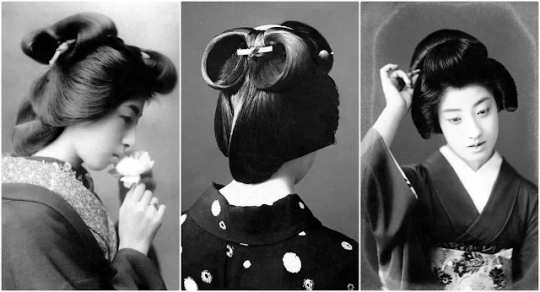

There are different hairstyles for different stages of a geisha's career.
Junior maiko wear the wareshinobu (split peach) style.
Senior maiko wear the ofuku style
Yakko is worn for formal events
Katsuyama is worn for one month before and one month after the Gion Festival in July
The sakko is worn in the final month of a maiko's training. On their very last day as a maiko, the tie holding their topknot is ritually cut off.
After becoming geisha, they wear the shimada hairstyle, an elaborate high chignon.
Mineko Iwasaki's description of the wareshinobu style:
The hair is swept up and sculpted into a mass on the top of the head that is secured by red silk bands (kanoko) front and back and decorated with kanzashi, the stick pin ornaments so distinctive of the karyukai look. It is said that this simple, elegant style showcases the curve of the young girl’s neck and the freshness of her features to their best advantage.
To preserve their elaborate hairstyles, geisha would sleep on a rectangular lacquered wooden pillow topped with a narrow cushion. If a girl found it difficult to sleep on these pillows, the maids would sprinkle rice bran around the pillow, so that if the girl removed the pillow, bits of bran would stick to the pomade in her hair, forcing her to have to go to the hairdressers again. Geisha would visit the hairdressers every five days.
These days geisha just wear wigs, which as well as being more convenient, also prevent bald spots from forming, a common problem geisha in the past dealt with due to constant stress on the roots of their hair. Maiko are still required to use their real hair.
Geisha also got their faces shaved when they went to the hairdresser.
As well as wearing their hair in elaborate styles, geisha also decorate them with ornaments. This description is of the first set of hair ornaments Mineko Iwasaki wore:
I wore two hairpins tipped with silk plum blossoms (because it was February) on the sides of the back of the bun, a pair of silver flutters (bira) on the sides in front, an orange blossom pin (tachibana) on top, and a long pin tipped with balls of red coral (akadama) and jade, inserted horizontally through the base.
Maiko wear colourful hair ornaments with flower motifs that change every month.
Full-fledged geisha don't wear as many hair ornaments, just a simple comb and hairpins, and their hairpins aren't as elaborate as the ones worn by maikos.
The hair ornaments serve purposes other than just decoration. The pointed ends of the pins are used to protect geisha from attacks, and the coral ornaments worn in colder months are used to test whether sake has been poisoned as coral breaks in the presence of poison.
Fashion


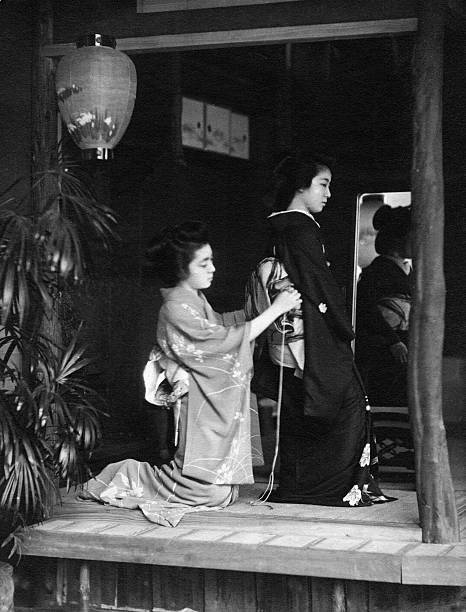
Maiko wear more elaborate outfits than geisha do in order to compensate for their lack of expertise and knowledge. Mineko Iwasaki described one of her maiko outfits this way:
My kimono was made out of figured satin in variegated turquoise. The heavy hem of the train was dyed in shades of burnt orange, against which floated a drift of pine needles, maple leaves, cherry blossoms and chrysanthemum petals. My obi was made of black damask decorated with swallowtail butterflies. I wore a matching obi clasp of a swallowtail butterfly fashioned out of silver.
I carried the traditional handbag called a kago, which has a basketweave base topped by a drawstring pouch of colorful tie dyed silk, shibori, which is made by tying silk into a myriad of minute knots with thread before it is dyed. The result is a stunning dappled effect. Kyoto is famous for this technique. It is the one that was practiced by my mother.
The shibori of my handbag was pale peach and sported a design of cabbage butterflies. It held my dancing fan (decorated with the three red diamonds of the Konoe family [close advisers to the emperor] painted on a gold background), a red-and-white hand towel decorated in a matching pattern, a boxwood comb, and various other accessories. All of these were encased in covers made from the same silk as the bag, and all of them were monogrammed.
Maiko wear a collar called eri, which is hand-sewn onto the nagajuban (a robe worn under the kimono) for each wearing. These red collars tell a story in and of themselves. They are made from silk that has been finely embroidered with white, silver, and gold thread. The younger one is the less dense the embroidery and the more visible the red of the silk. As one matures, the appliqué becomes heavier until little red (a symbol of childhood) can be seen. The progression continues until the day one “turns one’s collar” from maiko to geiko and begins to wear a white collar instead of a red one.
Under their clothes, geisha wear two rectangular undergarments made of cotton, one wrapped tight around the chest and the other wrapped tight around the hips. This helps flattens and smoothes the lines of the kimono. Next comes a long cotton hip wrap, like a half-slip, then a pair of long bloomers to preserve modesty should the front fold of the kimono open.
Next comes the hadajuban, a loose blouselike garment that follows the lines of the kimono. A maiko’s hadajuban has a red collar. Over this, a full length under robe is worn called a nagajuban. Mineko Iwasaki described hers as being "made from tie-died silk figured with a fan-shaped pattern and embroidered with an assortment of flowers."
After their undergarments are on, the kimono and obi (sash) are put on. Their kimono and obi have different designs for each season. For example, in summer, a kimono with hydrangeas might be worn and in Autumn a kimono with maple leaves might be worn. Kimonos for the winter months are made from thicker silk than kimonos for the warm months.
Geisha wear kimonos with more subdued colours and shorter obis than maiko do. A maiko's long obi will sometimes have the crest of the okiya she lives in on it. The clothes worn by geisha and maiko alike are made of expensive silk and are tailor made.
Geisha aren't dressed by themselves, but rather they have professional dressers who dress them every day. The dressers must ensure perfection, and they are the ones who bear the blame if anything is missing, out of place, or seasonally inappropriate.
Mineko describes a maiko's shoes as thus:
Kimono are always worn with either wooden or leather sandals. Okobo, 6-inch-high clog-like wooden sandals, are a distinctive part of a maiko’s outfit. The height of the sandal is a counterbalance to the dangling ends of the maiko’s long obi. Okobo are difficult to walk in, but the mincing gait they ensure is thought to add to the maiko’s allure.
Maiko and geiko always wear white tabi socks. The big toe of the tabi is separated, like a mitten, so that the toes can grip the sandal easily. We wear socks one size smaller than our shoe size, which leads a neat and dainty appearance to the foot.
First year maiko's shoes have little bells dangling from them that makes a sound when they move. Geisha wear flat zori or geta rather than okobo.
The finishing touches to a geisha's outfit are a kimono bag and a fan.
Skincare
We don't know what geisha did when they were sat in front of their mirrors after removing makeup, but we can speculate based on the kind of skincare Japanese women used in times past.
Translucent, white skin was a Japanese ideal of feminine beauty, so they might have used whitening face creams. Camellia oil is commonly used as a cleanser, moisturiser, and to remove makeup in Japan. Rice bran is also used as a cleanser (it's good for dissolving binsuke) and ground azuki beans are used as an exfoliater. Cooled green tea, full of antioxidants, is used as a toner. Squalane and seaweed are used as moisturizers. Parasols are used to protect the skin from the sun.
Mineko Iwasaki describes a bath she took after a long day:
I lowered myself gingerly into the steaming water and soaked until my skin was supple. Then I got out of the tub and, with a bucket and hot water from a spigot in the wall, washed thoroughly with soap and water. Next I rubbed myself all over with a net pouch filled with rice bran. Rice bran contains a significant amount of Vitamin B and is great for the skin. Then I got back in the tub for a final soak.
Geisha also bathe in onsens.
Perfume
We do know geisha wear perfume, but specific fragrances are hard to pin down.
Guerlain made a perfume called "Yakko," inspired by the geisha Sadayakko, who was the first geisha to travel Europe, inspired Puccini's opera Madame Butterfly, and licensed her name to a range of beauty products. It's hard to find any information on the Yakko perfume or what notes it contained, but Guerlain's famous Mitsouko perfume came out in 1919. Inspired by Japan, it contains bergamot, peach, jasmine, rose, and spices.
In the early 20th century, perfumes by French designers like Guerlain, Coty, Chanel and Patou became fashionable among upper class Japanese women, so it's possible geisha used fragrances from these houses to further enhance their allure.
Mineko Iwasaki described one of the first geisha she knew as wearing strong perfume, which caused a cloud of scent to waft into the room every time she fluttered her fan, so perhaps in times past geisha wore perfumes with loud projection that helped them be noticed. In modern Japan, strong perfume is unpopular, as it can bother people on public transport and interfere with the smell and taste of food in restaurants. Geisha, being the perfect hostesses, may not choose a heavy perfume in the modern era so as to follow etiquette and not disturb their clients while they're enjoying a nice meal. Brands known for their light perfumes like Maison Margiela and Diptyque are top-sellers in Japan.
Until the mid 19th century in Japan, it was common for women to scent their kimonos by leaving them on top of an incense burner in a small cage.
Geisha and oiran (courtesans) would carry pieces of scented wood in their sleeves, and would rub scented powder into their hands and necks.
Misc
Mineko Iwasaki described carrying a handbag which contained her fan, a hand towel, lipstick, comb, and a small cushion. Every item had its own carrying case made from Eriman red silk and monogrammed in white with the characters for Mineko.
Shiseido, a brand which is still going strong today, was founded in Japan in 1872. Among their most popular early cosmetics were scented hair tonics and floral perfumes, which were considered to contribute to the brand's luxurious image, helping to make it popular with Japan's upper class. Geisha were at the forefront of beauty and sophistication, so while there's no documentation of it, it's likely that some of their products found their way into the toilettes of geisha due to its prominence in early 20th century Japan and sophisticated image.
Tatcha, founded in 2009, is inspired by geisha beauty routines. The founder of Tatcha interviewed a geisha in Kyoto who was willing to share some of the closely guarded geisha beauty secrets, which would form the inspiration for Tatcha.
A big part of the geisha's appeal isn't just her looks, but her demeanor, the way she moves, and her conversational skills. Geisha train in dance and traditional Japanese arts and are experts at having sophisticated conversations. Not going to go into too much detail as it's its own topic, but it's good to remember that a big part of their mystique comes from their talent, grace and etiquette, not just their physical beauty. They're the full package, not just part of it.
22 notes
·
View notes
Note
Are there any occasions/events outside the yearly Odori tea ceremony where geiko wear the kyoufuu shimada?
No, it's only worn for tea ceremonies ^^
10 notes
·
View notes
Text




January 2019: Geiko Fukuchō (Shigemori Okiya) of Miyagawacho showing off her unique, gorgeous formal kimono she wore during the new year’s celebrations.
This is so cool, I don’t think I have ever seen a kimono featuring a shrimp motif!
Source: tomoko.kikuehotel on Instagram
#fukuchou#shigemori okiya#miyagawacho#kimono#hikizuri#susohiki#kosode#kuromontsuki#obi#obiage#obijime#oshiroi#makeup#katsura#wig#geiko shimada hairstyle#hairstyle#hair#geiko shimada#nihongami#geisha makeup#shironuri#white makeup#geisha#maiko#geigi#geiko#tomesode#eri#karyukai
473 notes
·
View notes
Photo
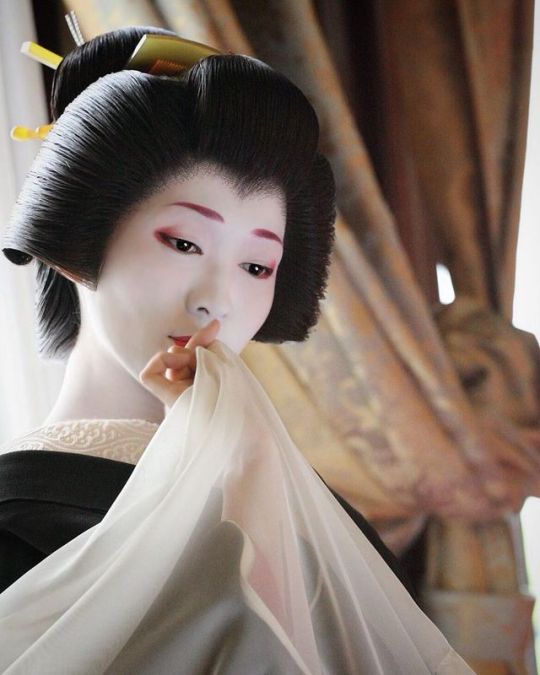
พฤศจิกายน 2561: เกโกะ Fukune (โอกิยะ Kawayoshi) จากเขต Miyagawacho ในจังหวัด Kyoto
Source: kuumill on Instagram
294 notes
·
View notes
Photo

Geiko Umechika with Maiko Umehina, Fumiyuki (Katsufumi okiya) and Umesana showing all stages of GeiMaiko. Umesana as a first year Maiko with a dangling kanzashi, Fumiyuki who already finished her first year but is still junior Maiko, Umehina with Yakko Shimada, a hairstyle only for special occasions and only worn by senior Maiko and finally Geiko Umechika who finished all stages of a Maiko, had her erikae and is now independent
(SOURCE)
#umeno#kamishichiken#2019#april#maiko#geiko#katsufumi#red#green#yakko shimada#wareshinobu#kanzashi#umehina#umesana#fumiyuki#umechika
78 notes
·
View notes
Photo

A Geiko (Geisha) dressed in the Genroku style, with her hair in the Shimada-mage hairstyle of the Middle Edo period (1688-1715). It is believed that the yujo (ladies of pleasure) of Shimada created the hairstyle. 1920s, Japan. Text and image via Blue Ruin 1 on Flickr
433 notes
·
View notes
Video
Umesato por Sarah Por Flickr: I headed out to Kamishichiken to see if I could get any good shots of maiko and geiko going to work, but the only good one I got was this one.
7 notes
·
View notes
Photo

“Threads of Tradition” ( 2011 by me, Marurenai). Please full view. It's all hand-painted (patterns of the kimono and of the background included). It takes me many many days. This is not a copy from a photo or a reference. She is an apprentice geisha in her first year of training and her make-up and Kanzashi are typical of a junior Maiko. Painted in photoshop with wacom bamboo tablet. Closeup details in previous post .
#geisha#geiko#maiko#marurenai#phoenix#kanzashi#kimono#wafuku#peony#asagao#kiku#kikyo#kaede#ume#bamboo#pine#iris#obi#shimada#japan#japanese#japanese girl#kyoto#manga#manga art#digital art#art#artists on tumblr#i#illustrators on tumblr
15 notes
·
View notes
Text
it’s been ten billion years since i’ve written a naboo headcannons post but the idea of writing one on foodstuffs and on textiles is. so tempting (honestly the textiles one is one that i would, ideally, do a whole series on for different planets and systems (and therefore different cultural/religious values, etc.) but this is, for now, simply An Idea)
and what’s giving me pause is how to reckon with the racist reasoning that lay behind the development of, in particular, the portrayal of naboo monarchy as something ‘alien’ and ‘intimidating’ while literally just copy+pasting japanese (lilac visitation robes (kimono), foreign residence gown (shimada hairstyle, probably more specifically the geiko shimada) and monogolian (senate outfit, headdress of a married khalka woman) attire, whereas her (romantic, familiarly (read: western) feminine) outfits in aotc were more inspired by european dress - right now i’m thinking of having high class naboo food culture be based on japanese and mongolian, while the lower class culinary traditions would be italian/french. the only scenes i can think of that feature food are both in aotc, with the pear scene and the deleted scene at padmé’s family’s home, which i would have to watch again for more ‘clues’. and probably easier to travel undercover as a lower class, so once again that could be used to bulk up this thesis
even with the space pear i could extrapolate an huge amount of what-ifs and guesses, i.e. pears have two domestication centers (china and central asia, and caucasus region), so it would ‘make sense’ for padmé to be eating higher class foods while at an official senatorial residence, vs. whatever foods her family would serve at home. but again. i don’t know if i’ll ever write this stuff up - right now it’s just an interesting thought exercise
#yes these are my current research interest areas. why do u ask#personal#this stream of consciousness post has a bibliography i'm kjhskjdf#other ppl concerned w/ worldbuilding: how long does it take to travel between systems? what's the time measuring system?#me: Where Did That Pear Come From And What Are The Implications Of It On Naboo Culture And Society.
24 notes
·
View notes
Photo


Nihongami: Hairstyles of the Karyukai - Geisha & Maiko
Historical Time Period: Late-Edo Period (1789-1853)
Hairstyle Name: Kyoto-style Geisha Shimada (京風芸妓島田) lit. "Kyoto-style Arts Person Rice Paddy Island”
This is a pompadour-like hair style, popular for unmarried women in the Edo period that is worn specifically by modern-day geiko during a strictly formal tea ceremony.
#kimono#nihongami#geisha#geiko#geishashimada#shimada#geishanihongami#geikonihongami#nihongamitimeline#karyukai#karyukainihongami
21 notes
·
View notes
Text
The look of... VIII: Shimizu 清水

Historical context The first official date in the history of Shimizu Geigi is 1872, when "Machi Geisha" (まち芸者), who were distinct from "Kaku Geisha" (廓芸者), appeared. A Kenban (registry office) was established in 1877. At that time, Machi Geisha and Kaku Geisha combined were around twenty people. Only ten years later, in 1887, their number had increased to 100. The number of Geigi continued to grow.
In 1938, the number of Geigi was around 260, and they were highly regarded nationwide for their skills in art and behaviour. In 1951, a "Shimizu Geigi school" (清水芸妓学校) was opened, around 150 Geigi attending the event.
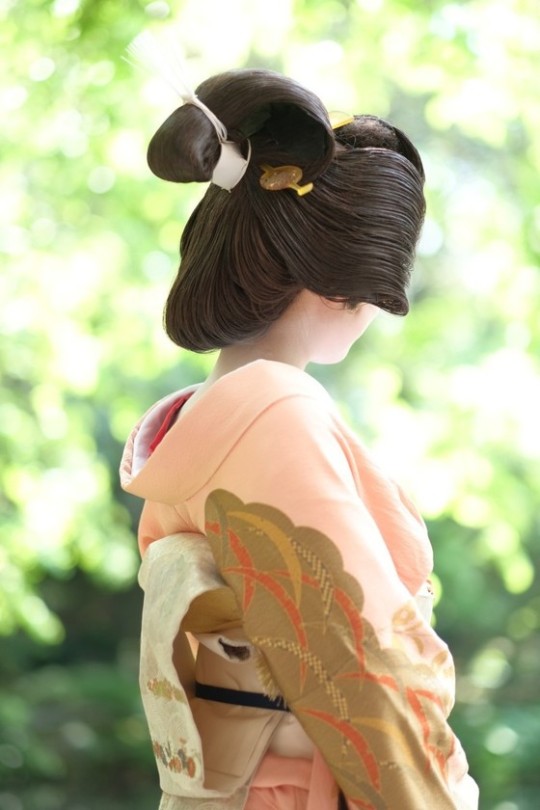
In the 1970's, Japan's period of economic growth started tapering off, interest in traditional arts dwindeled, which resulted in less work opportunities for Geigi and the number of Ryotei decreasing. In response to this, local business leaders and Shimizu Geigi started an organisation to help fostering new Geigi (Seibikai 清美会).
By 1985, their number had decreased to thirteen and the Kenban closed. In 1991, local businessmen and Geigi formed a different company (Seibi Co. 清美(株)), which worked as employer for Geigi. Due to a bad economic environment, Shimizu Odori (清水をどり) was last held in 1998, Seibi Co. was dissolved in 2004, and Haru no mai (春の舞) was discontinued in 2009. As a result of this, some of Seibi's employees became independent Geigi.
Allegedly, the number of Geigi hit rock bottom in 2011 with only two remaining. However, in 2012, around eleven Geigi worked in Shimizu. Since then, the city had a steady stream of Geigi coming and going again. At the end of this year, 2023, there are ten Geigi working in the city.
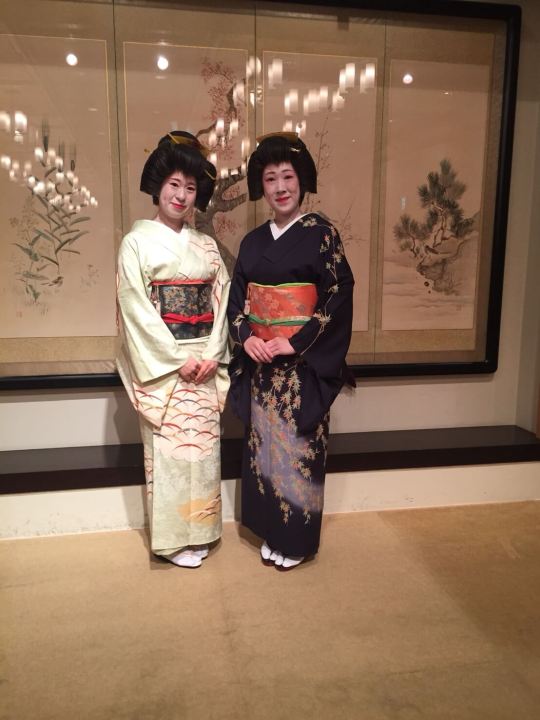
The look of Shimizu Geiko Local Term: Geigi 芸妓 ※ Hairstyle: Taka shimada, Tsubushi shimada ※ Kanzashi: Kushi, Maezashi, bekko kogai, ear of rice in the new year period ※ Kimono: Homongi, Kuromontsuki Hikizuri ※ Haneri: white ※ Obi: Taiko musubi ※ Obiage: green, pink, white, red ※ Obijime: flat, 1 knot ※ Footwear: Zori

Casual look ※ Hairstyle: Yohatsu ※ Kanzashi: none ※ Kimono: Homongi, rarely Komon ※ Haneri: white ※ Obi: Taiko musubi ※ Obiage: white, pink ※ Footwear: Zori

The look of Shimizu Maiko Local term: Shinjin Geigi 新人芸妓 ※ Hairstyle: Momoware Katsura, sometimes real hair styled (shin nihongami) ※ Kanzashi: seasonal and non-seasonal Hanakanzashi, Katsuyama, maezashi, Shidare in all age groups ※ Kimono: Furisode with shoulder tucks or no tucks at all ※ Eri: white with white embroidery, plain white, white with multicolour embroidery, other colours possible especially during summer months ※ Obi: Koken musubi ※ Obiage: flat, mostly red/silver, red/white shibori, other colours also possible (green/beige/light blue) ※ Obijime: flat or round with 1-4 knots. No obidome ※ Footwear: Zôri

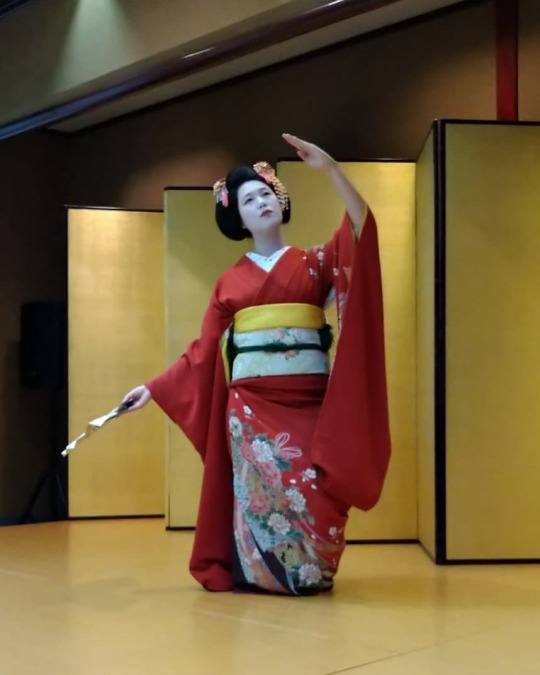
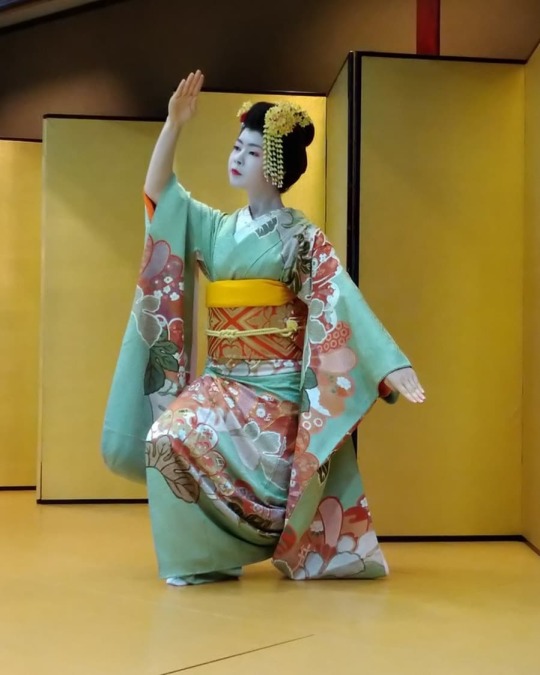
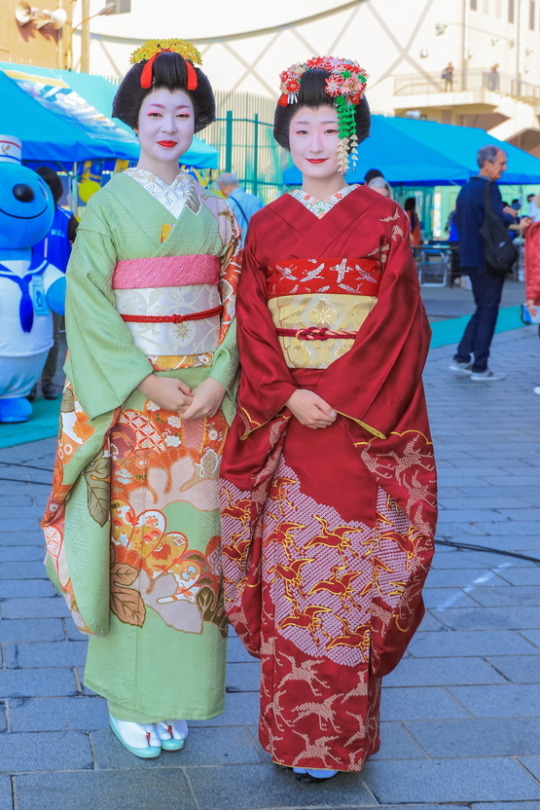
Notes Shimizu was merged with Shizuoka in 2003. Shimizu Geigi and other traditional arts performers are backed by 静岡伝統芸能振興 Shizuoka dentô geinô Shinkô-kai/Shizuoka traditional performing arts promotion association, which is the successor to Seibikai. You might notice I didn't start this post with a historical b/w photo. There are some old photos on the Shizuoka Dentogeino homepage, but they are the size of a postal stamp. And that's it. I feel let down. No chance to explore the historical style of Shimizu. Anyways. "The look of Shimizu/Shizuoka" was requested by @geimaiko. The layout of this post is based on geimaiko's own. Also... geimaiko originally started these series. If you liked this post, you should go and thank her, because without her, there would be no "the look of..." ;)
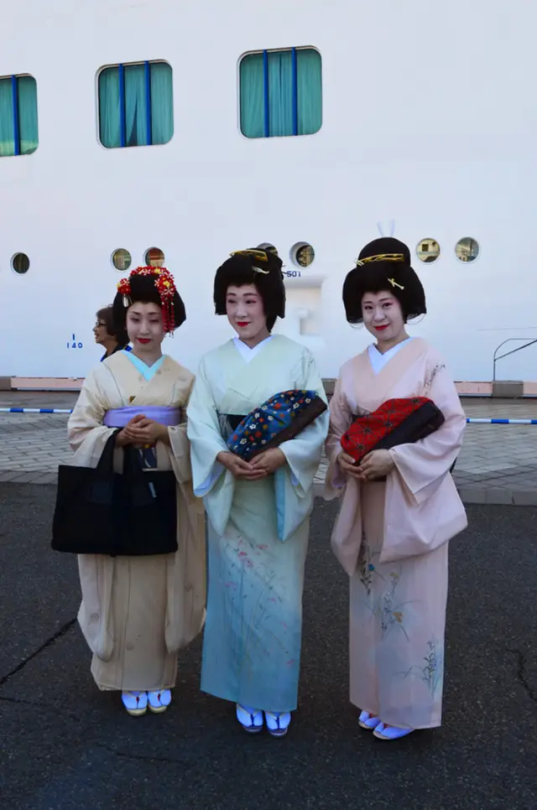

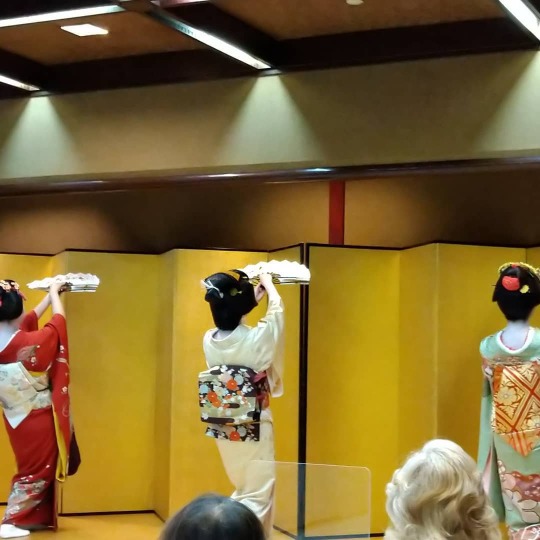
Sources https://www.shizuoka-dentogeino.jp/geigi/shizuoka_history/, https://www.shizuoka-dentogeino.jp/geigi/shimizu_history/, http://www.shimizu-port.jp/geigi.html, https://www.nikkei.com/article/DGXNZO41971500Z20C12A5L61000/ (headline and preview only), https://www.youtube.com/@shizuokadentogeino/videos
Pictures: Komachi May 17, Makoto May 17, Komachi+Makoto Oct 17 (sources nowhere to be found), Sakurako+Fukutaro Apr 22, Kikuno+Umeka Nov 14, Iroha Jun 20, Iroha Oct 20, Fukutaro Oct 20, Ichiryo+Komachi+Makoto ~2016, Komachi+Sakurako Apr 18, Fukutaro+Sakurako Oct 18, Iroha+Fukutaro+Sakurako Oct 20
#mg#geisha#geiko#maiko#hangyoku#geigi#shizuoka#kimono#komachi#makoto#sakurako#fukutaro#kikuno#umeka#iroha
116 notes
·
View notes
Photo

April 2017: geiko Chiyoko wearing striped kimono, hakata obi, and chu shimada hairstyle (special one for Miyako Odori performance) by nagayoshi.gofukuten on Instagram
༼ つ ◕◡◕ ༽つ Geisha-kai on P a t r e o n || Instagram
212 notes
·
View notes
Note
Why do geiko style their own hair for the miyako odori ? And is it in the same hairstyle their wigs are in ?
Geiko style their hair in the kyofu shimada style for the tea ceremony of the Miyako Odori as a way of keeping traditions alive. Geiko in other districts will also style their hair in the kyofu shimada style for the tea ceremony at their odori too. A geiko's wig is in the geiko shimada style, which is a variant on the taka shimada style ^^
12 notes
·
View notes
Photo

December 2017: Geiko Fumika (Yoshifumi Okiya) of Miyagawacho cuddling with her okiya’s cat.
Source: Yoshifumi on Instagram
#fumika#yoshifumi okiya#miyagawacho#kimono#hikizuri#susohiki#kosode#obi#oshiroi#makeup#katsura#wig#geiko shimada hairstyle#hairstyle#hair#geiko shimada#geisha makeup#shironuri#white makeup#geisha#geiko#geigi#maiko#karyukai#japan#japanese
136 notes
·
View notes